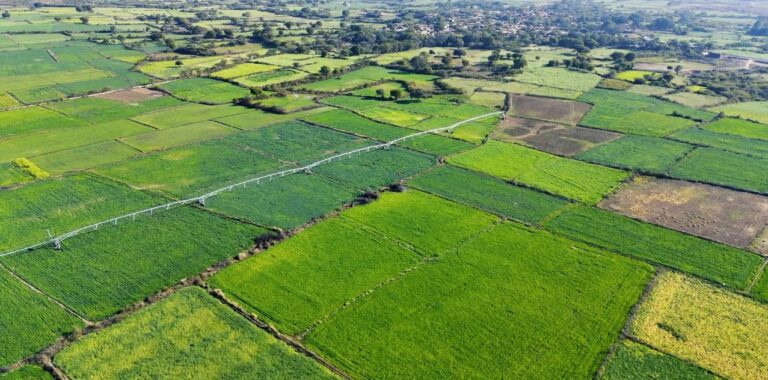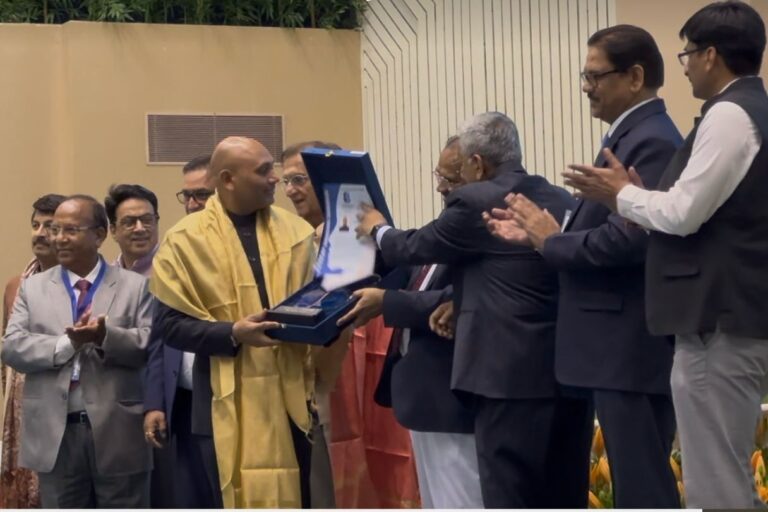
 By Dr Prem N. Sharma*
By Dr Prem N. Sharma*
This is the concluding part of the article on the state of global Green House Gases (GHG) emissions, especially from agriculture-related activities including land use change, forestry, pasture lands, livestock and crop production and recommends technical and policy options for their mitigation and adaptation globally.
Also read: State of global Green House Gases emissions – 2
Technical measures to mitigate GHG emissions in agriculture
i. Role of water in Carbon sequestration
The water cycle will see major changes e.g. increased frequency of extreme weather events like drought and flood cycles and heat stress affecting crop/livestock productivity and rural livelihoods, increased evapotranspiration (ET), drying of water bodies and river lets etc, all due to increased global warming. Most appropriate and strategically planned participatory rural development (RD) activities will have a positive impact on adaptation to climate change as they reduce the venerability of local communities to shocks and increase their resilience. Water harvesting itself can sequester 3.9-4.8 tCO2eq/ha/year from the influenced command areas. Along with appropriate participatory watershed management/RD activities themselves can sequester up to 6 GtCO2eq/year, if applied globally (IPCC, 2007). Thus adaptation to climate change water management and associated conservation practices in agriculture, are most important. Given that intensive agriculture is the highest user of water for irrigation, there is much more scope for mitigation actions that address the efficient use of water for agriculture. Hence, an approach that views potential responses to climate change through a ‘water lens’ must be used when designing Climate Smart Agriculture (CSA) adaptation strategies both for irrigated and rain-fed agriculture as well as investments in water resources and agriculture infrastructure.
Srinivasa Rao et al (2019) of the Indian Council of Agriculture Research (ICAR) summarise these CSA practices well for Indian conditions where the frequency of flood and drought, heat stress, cyclones and glacier melt has clearly increased due to recent temperature rises. This unpins the important cross-cutting role of in situ and ex situ water management well known (ridges, broad bed, furrows, graded bunds, terracing, water harvesting etc) for ages and promoted by various Civil Society Organizations (CSO) as well as Government of India (GOI) for a long time. Increased heat stress in northern India in 2021 is reported to have reduced spring wheat production by 3-7% and fortnightly milk productivity by 0.42-0.67% per unit of Temperature Humidity Index ((THI=T-0.55)(1-Rh) (T-58), where T=Air temperature in 0F and RH=Relative humidity (as a number from 0-1)). For cattle, THI >72 is comfort zone,72>THI<79 is mild stress, 80>THI<89 is moderate stress, and >90 severe stress)) above critical level.
ii. Sustainable land management (SLM) practices
The World Bank (2012) has posted a Geographical Information System (GIS) database for agriculture projects modelling estimates of SOC sequestration per ha/year using different SLM practices for different locations for a period of 20-25 years. While global CO2 emission from the land mass is net zero, agricultural activities related to CH4 and NO2 emissions are 50% and 60% of their total, respectively. Also, large quantities of soil displacement (globally 0.8-1.2 Gt C/year from about 75 Gt soil) takes place due to erosion, moving with it Soil Organic Carbon (SOC) (about 50% of SOM or 1-5% of topsoil), some of which gets released to the atmosphere by mineralization though most get deposited locally, or into the landscape/watershed or on a global scale. For optimum social benefits, farm scale management decisions should be based on wide public policy, markets, and suitable trade-offs between profitability and C sequestration for various SLM practices on whole farm systems in a landscape. Table 8 adapts and summarizes the abatement rate in tCO2eq/ha/year across the globe ranging from Latin America, Asia and African regions. It is the incremental net rate of C sequestration by the SLM practices listed in Table 9. This is compared to conventional practices including the difference in energy use during their entire process.
Table 9: Abatement rate (or net sequestration) of land management practices (World Bank, 2012)
| Sustainable Land Management (SLM) practices | Abatement rate, tCO2eq/ha/year |
| Judicious inorganic fertilizer application in crops | (-)0.23-0.29 |
| Manures (reduces 20-30% of manure weight) | 2.2-2.7 |
| No-tillage (with mulching/residue management) | 0.9-3.5 |
| Crop rotation (reduces 7-10% of emissions) | 0.7-1.5 |
| Cover crops | 1.7-2.4 |
| Supplemental irrigation and intermittent rice irrigation reduces by 50% CH4 compared to flooding | 0.2-3.4 |
| Water harvesting | 3.9-4.8 |
| Terracing/slope barriers | 2.4-5.3 |
| Agro-forestry, Agro-silvo-pastoral systems: | |
| – Intercropping near trees | 4.6-6.3 |
| – Crops with leguminous trees | 4.6-6.7 |
| – Alley cropping (with leguminous shrubs/perennial trees) | 7.6 |
| – Tree-crop farming | 7.5 |
| – Trees in fallow ( Improved fallow) | 8.7 |
| Land use changes: | |
| – Crop to grassland | 2.6 |
| – Pasture improvement | 3.21 |
| – Crop to pasture land | 5.7 |
| – Crop to forest land | 6.7-7.5 |
| – Pasture to plantation land | 6.7-7.5 |
| BIOCHAR application (with crop residue/mulch incorporation) | 10.3-15.7 |
iii. Crop management practices
About 75 Gt of topsoil is displaced annually depending on erosivity, in an inversion from sloping lands, which dominate the earth’s landscapes, to lower lands redistributing with it C and N in their SOM (1-5% of topsoil) and minerals. Global rates of erosion may increase by 1.7% for every 1% change in the total amount and intensity of rain due to global warming. Likewise, it can increase due to droughts which reduce green cover and increase forest/pasture land fires. Even though globally, overall erosion may be a net zero C sink (except CH4 and NO2) but its control is critical to protecting our natural soil resource in situ/locally and maintaining ecological roles in carbon sequestration. Table 9 gives some approximations of the potential of CO2 sequestration by various soil and water management, climate-smart agriculture (CSA) management practices, organic farming, intermittent rice irrigation, manure management etc. practices.
iv. Pasture land management practices
A list of proposed measures for mitigating GHG emissions from grassland, their apparent effects on reducing emissions of individual gases (mitigating effect) and an estimate of scientific confidence that the proposed practice can reduce overall net emissions based on a meta-analysis of 150 studies globally with an agreement in 74% studies made by Soussana et al (2010) is adapted in Table 10. An estimate of SOC sequestration in tCO2eq/ha/year in the top 30 cm of soils, is also given from various sources, studies, and models. These studies show that up to 6.24 tCO2eq/ha/year of GHG can be mitigated by grasslands globally vis a vis only 3.3 by other arable lands.
v. Livestock management practices
Table 11 is also adapted from Soussana et al (2010), which informs of the GHG mitigation effect of various livestock management improvements, measures and practices. It is noteworthy, however, that while sequestration is for sure expected, there is a need for further work to harmonize these data with information that may be scattered over various research institutions or private industry laboratories.
Policy options to mitigate GHG emissions in the agriculture sector
i. Sustainable land management on forestry and croplands
Agriculture Land management has the potential of reverting up to 24% of total GHG emissions from various types of land uses (forestry, pasture and crops). With the rise in per capita incomes of the world population, the inverted U-shaped relationship between income and environmental degradation, known as the “environmental Kuznets curve”, gives hope that
Table 10: A list of proposed measures for mitigating GHG emission by pasture land management
| Measure | Practices/
Techniques |
Abatement ratea (1 CO2 = 3.67 C) | Confidenceb | |||||
| CO2 | CH4 | N2O | tCO2eq/ha/yr (30 cm soil) | Agree | Evi-dence | |||
| Global overall improved arable lands potential | + | 3.3 | *** | ** | ||||
| Conversion to bio-fuels crops | + | 1.8-2.9 | + | * | ||||
| Overall improved management | + | 6.24 | *** | ** | ||||
| Grazing land manage-ment/
pasture impro-vment |
Set-aside lands, appropriate land-use change | + | + | + | 1.8 | *** | ** | |
| grazing intensity | ± | ± | 0.22 | * | * | |||
| Increased productivity by fertilization | + | ± | 0.5-1.6 | ** | * | |||
| Nutrient management | + | ± | ** | ** | ||||
| Species introduction | + | ± | * | ** | ||||
| Agro-silvo-pastoral | 6.6-13.95 | |||||||
| Fire management | + | ± | 0.37-4 | * | * | |||
| Rotational grazing | + | 0.37 | * | * | ||||
| Avoid drainage of organic soils | + | − | ± | ± | ** | ** | ||
| Desert control measures and soil restoration | 0.9-1.3 | |||||||
| Restoration of degraded lands by erosion control, organic amendments, nutrient amendments | + | ± | 0.7-0.73 | *** | ** | |||
| Desertification control: Full package: restoration of degraded lands, appropriate land use, crop and pasture land management practices | + | 3.67 | ** | ** | ||||
a ‘+’ denotes sequestration (positive abatement rate or mitigative effect); ‘−’ denotes increased emissions or suppressed removal (negative abatement rate or/mitigative effect); ‘±’ denotes uncertain or variable response.
b An* denotes a qualitative estimate of the confidence in describing the proposed practice as a measure for reducing net emissions of GHGs, expressed as CO2 eq. ‘Agree’ refers to the relative degree of agreement or consensus in the literature; ‘Evidence’ refers to the relative amount of data in support of the proposed rate/effect (the more *s, the greater the amount of evidence in both cases).
Table 11: A list of livestock management practices for mitigating GHG emissions
| Measure | Practices | Abatement ratea | Confidenceb | |||
| CO2 | CH4 | N2O | agree | Evidence | ||
| Livestock management (to reduce enteric fermentation | Improved feeding practices | + | *** | *** | ||
| Specific agents/dietary additives (ionophores, fatty acids etc) | + | ** | *** | |||
| Long-term structural & management changes & animal breeding for higher productivity | + | ** | * | |||
| Manure/
bio-solid management |
Improved storage (lower PH)/handling, covered shaded composting | + | ± | *** | ** | |
| Anaerobic digestion | + | ± | *** | * | ||
| More efficient use as a nutrient source (SOM incorporation & application) | + | + | *** | ** | ||
| Bio-energy: crops, solid, liquid, biogas, residues | + | ± | *** | ** | ||
Note: a, b, +, -, *, ± symbols as explained under table 9.
The willingness to act for environmental protection is going to increase with time. Likewise, environmental public perception has started becoming a significant factor in political decisions. However, given the neglect that the sector has received so far, it can only be hoped that even minor changes could bring about a major impact. In general, environmental policy implementation hinges on a combination of regulatory approaches and economic instruments. Other additional instruments include technical support and related capacity building, institutional development and infrastructure development. Salient recommendations are:
- Stop deforestation completely as already pledged by 100 countries. Other to be made to follow. Fully implement these political commitments locally on the ground. N-E India needs to make a push in this.
- Define land tenure, private or communal, clearly as a pre-requisite to all SLM actions.
- Make land use plans according to land capability so that unsustainable land use changes are arrested especially on sloping lands.
- Stop land use changes and promote conversion to better uses for nature conservation and C sequestration with profitability to farmers. This follows the below order:
Biochar>Native forestry>plantations>agro-forestry/silvopastoral systems>pasture>croplands
- Mainstream water harvesting, soil and water conservation, and their judicious use and restoration are the main focus for all land development and management investments.
- As soil organic matter incorporation and its decomposition depend on the moisture content of the soils, for reduced water use (8% in the livestock sector globally) introduce water pricing, limit inputs, proper equipment, zoning regulations and taxes to discourage large concentrations near cities. Also, secure water rights making it a part of watershed/landscape management.
- Promote more research in climate-resistant crops, fodder and tree options.
- Make sufficient investments available to farmers as well as public institutions for implementing the SLM practices on all land use types. They also give high returns on a 20-25 years cycle.
ii. Pasture and livestock management
Overall, there appears a general lack of understanding among various stakeholders on the nature and extent of livestock’s impact on the environment. The broad and complex interactions between the two are not easily segregated and understood adequately. The remoteness of livestock production in many of the world’s marginal areas further reduces the reach of regulatory authorities. Livestock products, especially dairy and beef, continue to be heavily subsidized amounting to almost 32% of total farm income in OECD countries. At the same time, the world’s pasture/grasslands have higher GHG emissions than the global road transport sector. Salient recommendations for related public policy are summarized below:
- Limit livestock’s land requirement by enhancing its productivity by reverting it back to woodlots in developing countries and forests in industrialized countries by the careful intensification of existing grazing lands, improved livestock, including the use of more efficient breeds, and increasing feed crop productivity and through set-aside land schemes.
- Promote research and development in cutting-edge technology to build on indigenous knowledge, for example, spiritually protected pastures and woodlots in many South and S-E Asian countries.
- Reduce overgrazing for halting grassland degradation by grazing fees and removing obstacles to mobility in common property pastures by the provision of long-term leases or land use rights in government/community grasslands and land titles where private investment is required.
- Correct distorting prices, for example, meat and milk subsidies in OECD countries and availing land and water without charges in developing countries that discourage efficient resource use, and foster misallocation and uncontrolled degradation of resources.
- Incentivise GHG sequestration by pastoralists, herdsmen and land owners and integrate them into environmental management and as protectors of bio-diversity and reserves/protected areas/national parks.
- Set standards and targets for improved feed to reduce enteric fermentation in animals, regulate the use of agrochemicals, manure’s storage and application (incorporation within 24 hours at 3 crop growth stages)| and make provision for fines and charges for non-compliance in case of feed and agrochemicals.
- As soil organic matter incorporation and its decomposition depend on the moisture content of the soils, for reduced water use (8% of global freshwater used for the livestock sector) introduce water pricing, limit inputs, proper equipment, zoning regulations and taxes to discourage large concentrations near cities. Also, secure water rights making it a part of watershed management.
- Integrate grassland/livestock sector emissions into national GHG reduction targets being provided voluntarily to UNFCCC so that investment can flow to mitigate emissions from grasslands. Make efforts to include GHG sequestration from grasslands as a part of the Land Use, Land Use Change and Forestry (LULUCF) category so that carbon sequestration from them can qualify for Clean Development Mechanism (CDM) carbon trading as Certified Emissions Reduction (CERs) or create other markets or ways of compensation. For example, GEF has promoted payments for carbon sequestration and biodiversity conservation on pasturelands in Costa Rica and Nicaragua.
Conclusion
In general, with sustainable water and land management practices in forestry, pastoral and croplands, and improved livestock practices achieved through appropriate policy measures, technical practices and operational techniques, the GHG emission can be reduced by up to 3.6-10 tons CO2eq/ha/year. This can help curtail global emissions by almost up to 30%. These practices include biochar applications, control of deforestation for pastoral, cropping and other land uses, setting aside lands, improved agroforestry/silvopastoral systems, intensification to reduce pressure on extensive grazing lands, soil and water conservation on sloping lands, improved breeds and feeds with additives for animals to reduce their enteric fermentation, improved bio-fuel, fertiliser and manure management including its storage, handling and application etc. This all will have to be underpinned by appropriate water harvesting, and management. These are all very well-known practices with proven efficacy but have often been ignored in the past, especially on extensive sloping and pasture lands. Hence, any improvement can have a significant impact. In addition, pricing mechanisms (of water, land, waste sink use, removal of perverse subsidies etc) by reckoning full economic and environmental costs can be effective. At the same time, assuring land, water, pasture and forest rights, can reduce environmental damage by deforestation, sloping lands erosion, and livestock production from grasslands. Reducing distorting subsidies, by paying for various environmental services (like watershed management, carbon sequestration) to herders, pastoralists and land owners, especially on extensive sloping and pasture lands and by integrating them into the spiritual and cultural relations with natural resources along with the use of cutting edge technology to build on indigenous knowledge, can go a long way in sequestering GHG and improving productivity in the forestry, sloping agriculture and pasture/grasslands, for a healthier earth.
*Retired International Senior Natural Resources/Watershed Management and Operations Officer of the FAO-UN on global postings across continents.





